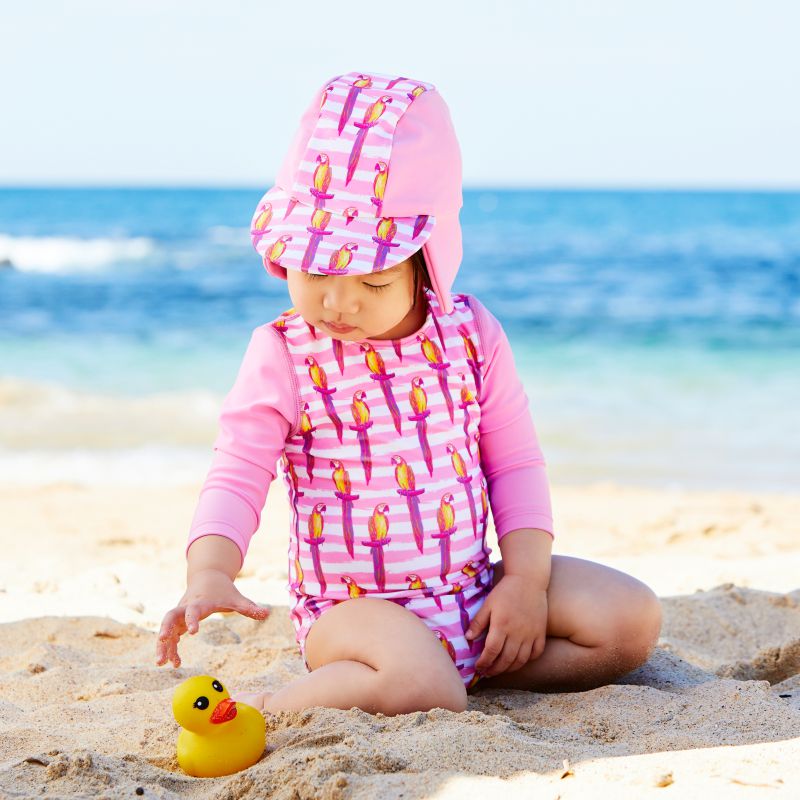Blog
Summer Skincare Tips for Babies

How to protect your baby’s skin this summer
It’s summer in Australia and that means more time outdoors paddling in the pool, swimming, building sandcastles at the beach or playing at the park. It’s all great fun, however, our hot Aussie sun can take a toll on your child’s skin. Baby skin is softer and finer than adult skin and it loses moisture at a much greater rate. We’ve listed our top summer skincare tips for babies to help you to protect their skin through the warmer months.
Choosing the best sun protection
Evidence suggests that childhood sun exposure contributes significantly to your lifetime risk of skin cancer. It’s important to take multiple approaches to protecting your child’s skin from sun damage.
- Choose a broad spectrum, SPF30 (or higher) natural sunscreen that contains zinc oxide as the active ingredient. The Little Innoscents SPF30 Natural Sun Lotion is a great choice for babies over 6 months of age. Apply to areas of exposed skin that are not covered by protective clothing, such as the face, ears, hands, neck and feet
- Avoid sunscreens that contain chemical UV blockers and other nasties such as parabens, octyl methoxycinnamate (OMC), oxybenzone (benzophenone-3), octyl-dimethyl-PABA and octinoxate, 4-methylbenzylidene camphor (4-MBC), padimate O (2-ethylhexyl-4-dimethylaminobenzoate), tints or artificial fragrances
- Cover up with a hat that protects the baby’s face, neck and ears and appropriate outdoor clothing to protect the skin, such as a long-sleeved rashie swimsuit. We recommend fabrics that are tested and approved with an SPF 50+ sun safety rating such as those available in the Australian Rashoodz range of rashies and hats for babies and children
- A pair of wraparound sunglasses will help to protect your baby’s eyes
- Try to plan your day’s activities outside the middle of the day when UV levels are most intense. Limit the time you spend in the direct sun and seek shade where possible
Keeping skin hydrated
Our Australian summers can be harsh on delicate baby skin, so keeping them hydrated is very important.
- First and foremost, always give plenty of fluids on warmer days spent outside. Breast milk is ideal, but if your baby or toddler has weaned, give them either formula or water and also fruit and vegetables with a high water content, such as watermelon are good choices for older babies who have started solid foods
- Moisturise once or twice a day with an Organic Baby Moisturiser to keep the skin hydrated from the outside. This is particularly important for those who suffer from sensitive skin or other dry skin conditions, as keeping the skin from drying out can be a useful preventative measure
- If the skin or lips do get too dry after a day outdoors, or a little too much sun exposure has occurred and caused sunburn, a quality, natural skin balm such as a Paw Paw Balm or an Intensive Soothing Baby Balm will go a long way to helping lock in and restore moisture and to heal and soothe it as quickly as possible
Preventing and Soothing insect bites
If you are in an area that is prone to lots of mosquitoes or biting insects, there are a few ways that you can tackle the problem.
- The best preventative measure is a toxic chemical free one. Dress in long sleeves and pants and if necessary, apply a natural or organic insect repellent to any exposed areas of skin (avoiding the eyes, mouth, hands or any areas of broken skin). Avoid products that contain DEET
- Ensure that you wash off any insect repellant that you have used on the skin once you head inside
- Use mosquito netting or a light muslin cloth over your pram
- If your child does get bitten, wash the area and apply a soothing balm such as Paw Paw Balm or an Intensive Soothing Lotion. If there are any signs of allergic reaction, such as swelling around the bite or hives, head to your doctor asap
It might all sound overwhelming, but once you have taken all the necessary precautions, make sure that you get out there and enjoy our beautiful Australian summer. I guarantee it will be worth it!
About the Author: Antonette Golikidis has studied Natural Health Science at the Australian College of Natural Medicine and is qualified in Remedial Massage Therapy and Aromatherapy. Currently, she lectures in Remedial Massage at a tertiary level.
*While the greatest effort has been invested to ensure the validity of this information, the advice therein is set as a ‘general’ guide only, and your individual needs may require a different method to the one shown. We encourage you to see your regular healthcare professional, should you be concerned for you or your baby’s wellbeing.




